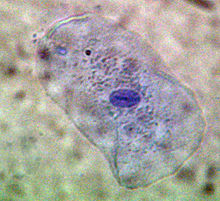mouth
This article has been registered in the quality assurance biology for improvement due to formal or content-related deficiencies . This is done in order to bring the quality of the biology articles to an acceptable level. Please help improve this article! Articles that are not significantly improved can be deleted if necessary.
Read the more detailed information in the minimum requirements for biology articles .

The mouth (with animals mouth called), Latin Os , is the body cavity and the surrounding soft tissues in the head, the upper part of the digestive tract forms. It is the body opening through which food is taken. In humans it is also used for voice production ( phonetics ) and in terrestrial vertebrates for breathing .
Depending on the living being and the external structure or function of the mouth, terms such as mouthparts , mouth or beak are used.
The mouth, or the oral cavity, together with the nose, is the first part of the air-conducting system which, together with the gas-conducting system, supplies the body with oxygen. Its mission is to clean the circulating air to heat, humidify and further into the throat ( pharynx to transport). In the event of an allergic reaction ( anaphylaxis ), the tongue located in the mouth can swell and block the airways.
etymology
That is common. Word mhd. Munt , ahd. Mouth is ambiguous: it can on the one hand with lat. Mentum "chin" to be used on the other hand it can in the sense of "Kauer" to the Indo-European. Root * menth- "chew" belong.
Developmental biology
Animals usually have a digestive system in which food is taken in through the mouth and excreted through the anus . Which of the two body orifices is formed first in ontogenesis determines the classification of the animals as primitive mouths ( protostomia, mouth first ) or new mouths ( deuterostomia, anus first ).
Some animals, such as cnidarians or vortex worms , do not have an anus; they excrete the digestive residues through the mouth. Arm pods do not excrete, they digest without leaving any remains. Some endoparasites , like tapeworms , have no mouth at all. As far as they live in the digestive system of a host, they can ingest constituents of its food directly through their outer skin.
Mouth of man
In humans, the mouth and its parts form the anterior opening of the human digestive tract. In it is digestive initiated. The three main parts of the mouth are:
- the gap in the mouth that is enclosed by the lips ,
- the atrium , which is located on the one hand between lips and cheeks and on the other hand between the upper and lower jaw along with rows of teeth and
- the oral cavity , with the floor of the mouth , the tongue and the roof of the mouth .
In addition to its digestive functions, chewing - i.e. chopping and salivating - it also serves to generate voice and can be used for breathing . The lips, together with the rest of the facial muscles, express human feelings. The oral cavity merges into the pharynx .
See also
Web links
Individual evidence
- ↑ Franz Keggenhoff: Manual medical service - The textbook for paramedics, Rettungshelfter and paramedics . Ed .: Deutsches Rotes Kreuz eV 9th edition. DRK-Service GmbH, Berlin 2017, p. 295 .
- ^ The dictionary of origin (= Der Duden in twelve volumes . Volume 7 ). Reprint of the 2nd edition. Dudenverlag, Mannheim 1997 ( p. 474 ). See also DWDS ( "mouth" ) and Friedrich Kluge : Etymological dictionary of the German language . 7th edition. Trübner, Strasbourg 1910 ( p. 322 ).

